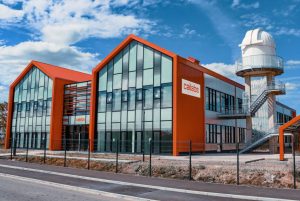Exceeding Throughput Limits with Laser Communications

Introduction
In today’s interconnected world, transmission speed has emerged as a pivotal aspect of our daily lives. There has been a general increase in the requirement for greater throughput, with applications reliant on satellite communications significantly contributing to this demand. Radio frequency (RF) communications, traditionally used for satellite-to-ground links, are now reaching their capacity limits. In this context, laser communication technology is emerging as a viable solution to overcome these throughput challenges. This article is the first of a three-part series exploring the benefits of laser communications compared to current transmission methods. In this first blog post, we will highlight the considerable throughput advantage offered by laser communications.
Current throughput requirements and limitations
Key sectors requiring high throughput:
Today, the demand for throughput is steadily increasing, driven by applications that generate massive amounts of data requiring real-time transfer. In the satellite communications sector, high throughput is essential for various critical activities, including Earth observation, satellite telecommunications, data relay via data relay constellations, cloud data transfer, and military applications such as naval and airborne communication bubbles, and scientific applications like deep space exploration.
Why demand for throughput is increasing in these sectors:
The rapid expansion of Earth observation, driven by the enhanced capabilities of satellites and hyperspectral cameras, has led to an abundance of images that require rapid transfer to Earth. According to NASA: “As science instruments evolve to capture high-definition data like 4K video, missions will need expedited ways to transmit information to Earth”.
In the defense sector, the emergence of collaborative warfare using data fusion techniques requires extensive bandwidth to interconnect stakeholders, enabling them to effectively leverage the data acquired in the field.
At the same time, the massive transfer of data to the cloud has become a standard practice for many companies, requiring ultra-fast connections to store, manage and analyze vast quantities of information.
In the telecommunications industry, space feeder links play an essential role in relaying large volumes of data to space, enabling simultaneous signal distribution to multiple users. This method is used by television operators and satellite internet service providers and requires the deployment of ultra-high-capacity uplinks.
The proliferation of data relay satellites facilitates the real-time transfer of large volumes of data between multiple locations around the world. This connectivity is further enhanced by optical inter-satellite links, which contribute to even higher data throughput rates across satellite constellations. Data relay operations require ultra-high-capacity bidirectional links to manage such high data volumes.
This broad spectrum of applications requiring high throughput highlights the need to develop solutions that can meet the growing demand for data transmission.
Why are satcoms no longer able to meet demand?
Satellites have traditionally relied on radio frequencies (RF) for their links with Earth. However, RF communications have inherent bandwidth limitations, typically capping at 512 Mbps or a maximum of 1 Gbps.
Faced with this limitation, stakeholders in the space industry are actively exploring connectivity solutions to meet their demand for high-throughput data transmission. In this context, laser communication is emerging as a response to the growing bandwidth needs of modern society.
How optical technology addresses today’s challenges
Advantages of laser communication:
Laser communications rely on the propagation of light in free space, providing significant benefits including low latency, low probability of detection and interception, resistance to jamming, and, most importantly, the capability to achieve very high data throughput rates, exceeding 10 Gbps.
Laser communications have benefited from decades of advancements in fiber-optic terrestrial telecommunications. This progress has resulted in economies of scale for optical components, facilitating the adoption of advanced optical technologies such as Erbium-Doped Fiber Amplifiers (EDFA). These amplifiers enable long-distance transmissions without the need for conversion, while coherent modulation formats maximize transmission distances and capacity, thus enabling very high throughput rates. In addition, laser communications are compatible with terrestrial fiber infrastructure, enabling continuity with an established and cost-effective communications network.
Optical communications achieve data throughput rates exceeding 10 Gbps, surpassing the throughput limitations of existing wireless transmission methods. In comparison, RF communications typically peak at around 1 Gbps. To provide a concrete example, downloading 1 TB of Earth observation data via RF at a high estimated throughput rate of 512 Mbps would take over 4 hours. However, using laser communications, the same 1TB of data can be downloaded in under 14 minutes at a rate of 10 Gbps. This download time is drastically reduced to less than 2 minutes when the rate is increased to 100 Gbps.
In addition, optical communications are inherently free from spectrum limitations, thus avoiding interference with other signals and the requirement for an operating license.
Laser communication demonstrations and initiatives
Here are some concrete examples of high throughput achieved with laser communications:
In 2023, there were multiple demonstrations of space-ground links. In April, NASA established a laser link from its TeraByte InfraRed Delivery (TBIRD) optical payload to Earth, achieving a throughput of 200 gigabits per second. This optical link enabled the transfer of 3.6 terabytes of data to Earth in just 6 minutes. To put this into perspective, the state-of-the-art James Webb Telescope transmits around 57.2 gigabytes of scientific data per day using radio frequencies at a maximum rate of 28 megabits per second.
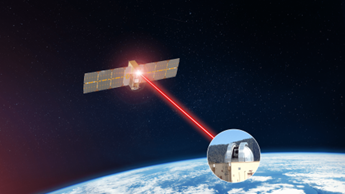
NASA: https://www.nasa.gov/centers-and-facilities/ames/nasa-partners-achieve-fastest-space-to-ground-laser-comms-link/
In Europe, the PIXL-1 satellite demonstrated a 100 Mbps laser downlink between the OSIRIS4CubeSat optical terminal, co-developed by the German Aerospace Center (DLR) and TESAT-Spacecom, and the Oberpfaffenhofen optical ground station located on the roof of the DLR.
In October, the Chinese company Changguang Satellite Technology (CGST) conducted a demonstration of a bidirectional laser link at a rate of 10 Gbps between the Jilin-1 satellite and its Optical Ground Station (OGS).
Meanwhile, the large-scale optical program European Data Relay System (EDRS) has been demonstrating its effectiveness since 2016. Implemented by ESA and the European Commission, with the SpaceDataHighway component operated by Airbus, EDRS facilitates data transfer between LEO satellites and Earth via GEO nodes. The optical inter-satellite link operates at 1.8 Gbps, complemented by KA-band RF links with 300 Mbps capacity. In 2019, SpaceDataHighway recorded over 25,000 successful laser connections with a reliability rate of 99.4% in its first three years of active operation, enabling the transfer of 1,500 terabytes of data.
In May 2023, Airbus successfully conducted a series of optical space-ground data transmission tests between GEO EDRS-C nodes and the T-AOGS (Transportable Adaptive Optical Ground Station), owned by DLR and TESAT. This test campaign established 66 links, accumulating 316 minutes of communication and enabling the transmission of 3.6 Tb of data.

These demonstrations validate the technical feasibility of space-to-ground laser links and the availability of the technology required to implement them. Today, these demonstrations have progressed beyond mere experiments and have evolved into fully or partly industry-driven initiatives using market-ready optical terminals.
Indeed, when it comes to optical terminals onboard satellites, several industry players have entered the field. Driven by the Space Development Agency’s (SDA) demand for optical terminals for its Transport Layer military telecommunications satellite constellation, companies such as CACI International, Skyloom, Tesat and Mynaric are marketing optical terminals that comply with SDA standards.
Space-to-ground laser communication initiatives:
A number of initiatives in space optical communication are currently underway, focusing on leveraging optical technology to develop new space infrastructures for massive global data transfer.
The HydRON (High Throughput Optical Network) project backed by the European Space Agency (ESA) aims to develop optical communications between satellites and ground stations, achieving throughput in the Tbps range while ensuring seamless integration with existing terrestrial networks. This endeavor could pave the way for almost unlimited connectivity for advanced applications, including 5G/6G and space-based internet.
In addition, the CO-OP consortium, led by Airbus Defence and Space, Thales Alenia Space and Safran under the supervision of CNES, is dedicated to developing the satellite optical industry in France. The consortium’s efforts are focused on using ground-to-GEO optical links to enhance communication capabilities between satellites and ground-based users. Cailabs is actively contributing to the project by developing an ultra high-power source (over 50 W) for a GEO feeder link designed to provide a very high-speed connection capable of achieving terabyte-per-second throughput.
Atmospheric turbulence:
Although feasibility demonstrations were conducted as early as the 1990s, space-to-ground laser communications did not take off due to a longstanding challenge: atmospheric turbulence. These disturbances, caused by the heterogeneity and constant movement of air, impact the phase and intensity of the light beam, thus degrading the quality of the link as it passes through the earth’s atmosphere.
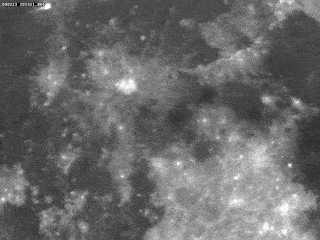
Optical communications become increasingly competitive compared to RF at data rates exceeding 10 Gbps. To establish a high-throughput optical link, it is essential to use standard telecom equipment, primarily consisting of single-mode optical fiber. Turbulence management becomes critical in this context, particularly for enabling coupling into single-mode fiber. This approach facilitates the use of EDFA amplification and coherent modulation, and also plays an essential role in focusing the signal on a high Signal-to-Noise Ratio (SNR) detector. A higher throughput rate requires a smaller detector, making it more sensitive to the effects of turbulence.
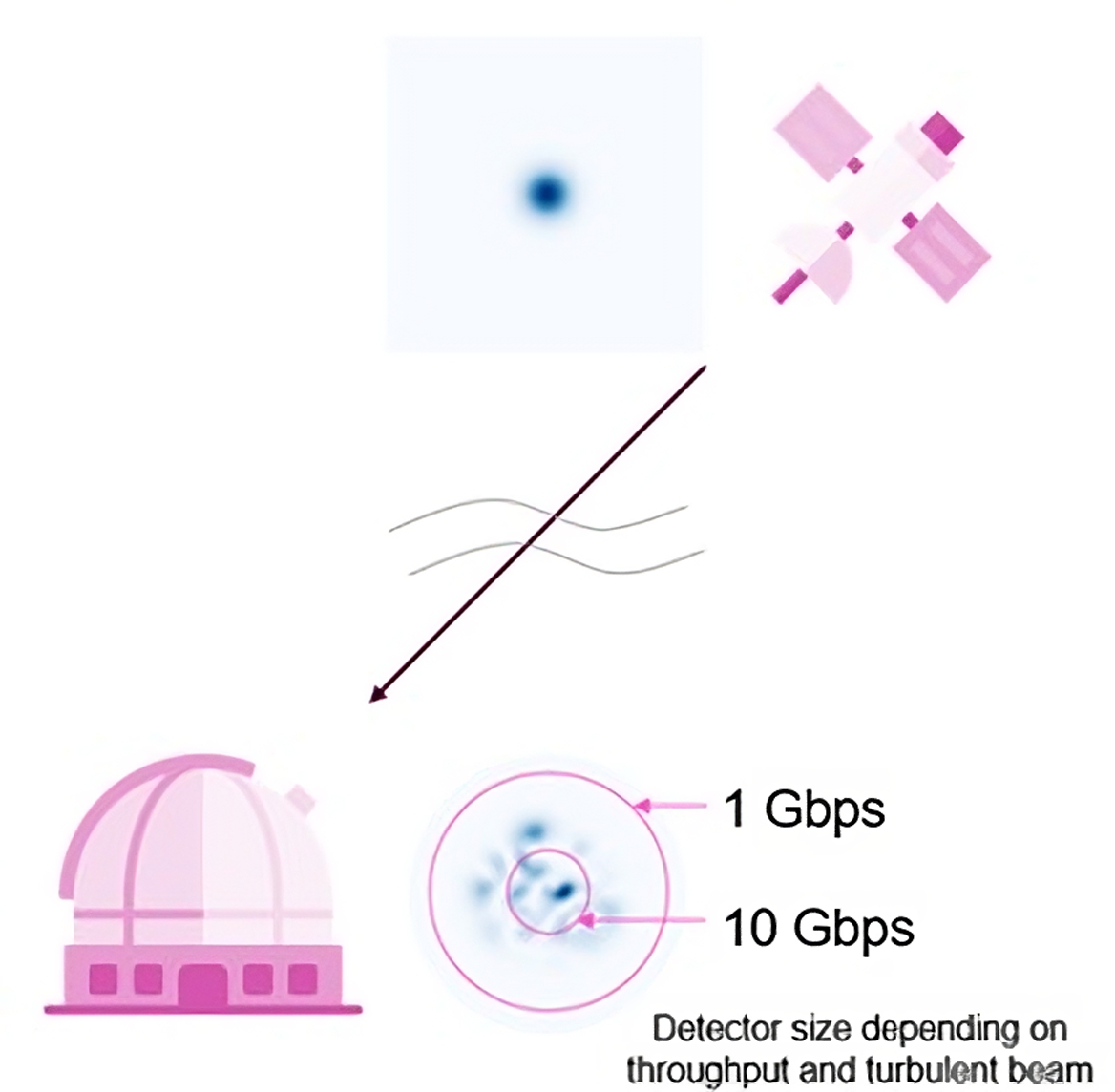
Today, innovative solutions are available to effectively mitigate this turbulence. One example is Adaptive Optics, a technique taken from astronomy, which uses large deformable mirrors to actively compensate for turbulence. However, this method may be limited in achieving the required correction speed for high-throughput optical communications. It is also complex to use and requires bulky, costly equipment.
Cailabs has developed two competitive technologies that are compact, robust, and operate passively. TILBA®-ATMO effectively captures all incoming light and passively converts it into usable modes without the need for active wavefront correction. TILBA®-IBC uses incoherent combining to enable turbulence correction during transmission.
Cailabs is establishing a strong presence in the ground segment of free-space laser communications through the development and supply of TILBA®-OGS optical ground stations, which effectively mitigate atmospheric turbulence during both transmission and reception, enabling the achievement of very high-throughput data rates (>10 Gbps).
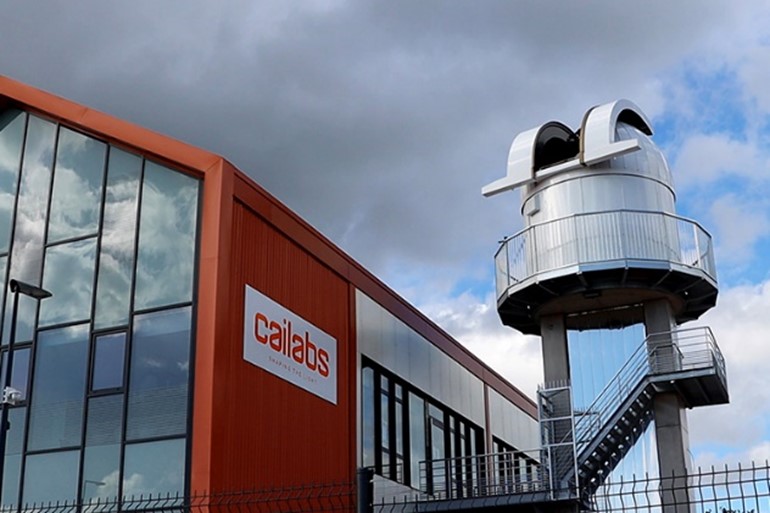
Our TILBA®-OGS stations are also scalable to meet future Tbps feeder link requirements through TILBA®-CBC coherent combining. This capability caters to the needs of telecom constellations and data relay systems, especially in geostationary orbit. The TILBA®-CBC technology module extends the range and throughput of ground-to-space optical feeder links to areas where telecom sources are currently limited.
Conclusion
Free-space optical communications are paving the way for very high-throughput data transfer, serving as a critical component of future communications networks. By complementing RF communications, free-space optical communications overcome throughput limitations, enabling very high-speed transmissions and eliminating the bottlenecks associated with RF communications. This technological advancement creates new opportunities for applications requiring high data transfer rates. The strong collaboration between businesses, government agencies, and research institutions is driving the development of laser communications technologies, leading to significant advancements in both ground-based and space-based communication systems. This synergy is fostering the emergence of a dynamic market in this field.
References:

By Tatiana Zaimskikh
Tatiana holds a bachelor’s degree in economics and geopolitics and a master’s in international trade. She is currently a Junior Product Manager on the TILBA® product line at Cailabs. With a keen interest in the space telecommunications industry, Tatiana plays a pivotal role in the development and marketing of the TILBA® range, dedicated to laser communications for space, land and airborne applications.
Our Other Articles:
-

Exceeding Throughput Limits with Laser Communications
-

The challenges of e-mobility: Welding busbars
-

Flying further with beam shaping
-

From the Volkswagen Golf to the Tesla Model 3: How Lasers Are Shaping the Automotive Industry?
-
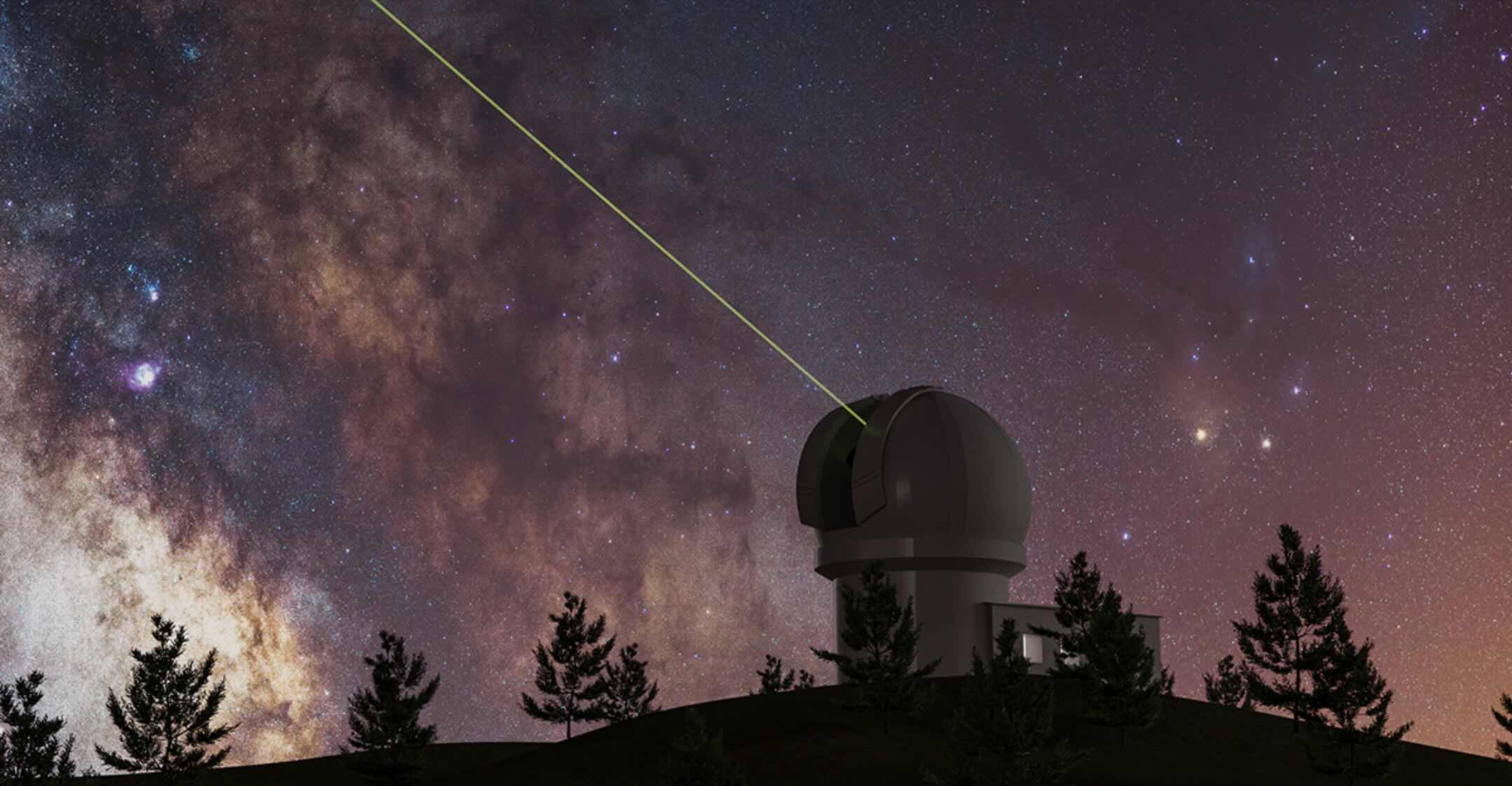
Space Optical Communications: Why Are Space-to-ground Links Taking Time to Develop?
